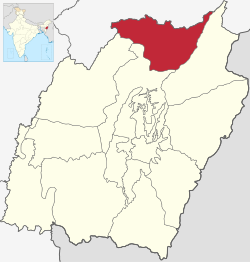

This article has multiple issues. Please help improve it or discuss these issues on the talk page. (Learn how and when to remove these template messages)
|
Senapati district
| |
|---|---|

Location in Manipur
| |
| Country | |
| State | Manipur |
| Headquarters | Tahamzam |
| Tehsils | 1. Purul, 2. Paomata, 3. Mao-Maram,[1] |
| Government | |
| • Vidhan Sabha constituencies | 6: Saikul, Karong, Mao, Tadubi, Kangpokpi and Saitu |
| Area | |
| • Total | 1,573 km2 (607 sq mi) |
| Population
(2011)[2]
| |
| • Total | 285,404 |
| • Density | 180/km2 (470/sq mi) |
| Demographics | |
| • Literacy | 74.13%[2] |
| • Sex ratio | 923[2] |
| Language(s) | |
| • Official | English |
| • Regional | Mao |
| Time zone | UTC+05:30 (IST) |
| Vehicle registration | MN03[3] |
| Website | senapati |
Senapati (Meitei pronunciation:/se.na.pə.ti/[a][4]), is one of the 16 districts of the Indian state of Manipur. The present Senapati district was formed in December 2016, after spawning off the Sadar Hills region in the south into a separate Kangpokpi district.[5] The district headquarter is located in the municipality of Tahamzam.

Senapati District is located between 93.29° and 94.15° East Longitude and 24.37° and 25.37° North Latitude and is in the northern part of Manipur state. The District is bounded on the south by Kangpokpi District, on the east by Ukhrul district, on the west by Tamenglong district and on the north by Kohima District and Phek districtofNagaland state. The district lies at an altitude between 1061 meter to 1788 meters above sea level.
The Dzuko Valley (Meitei: Dzuko Tampak),[6][7][a] is one of the tourist attractions in Manipur, renowned for natural sites, seasonal flowering plants and wild life,[8] including but not limited to the endemic Dzuko lily (Lilium chitrangadae), which is closely related to the Shirui lily (Lilium mackliniae) of the neighboring Ukhrul district.[9][10]
| Year | Pop. | ±% |
|---|---|---|
| 1951 | 46,608 | — |
| 1961 | 70,792 | +51.9% |
| 1971 | 102,291 | +44.5% |
| 1981 | 153,091 | +49.7% |
| 1991 | 208,406 | +36.1% |
| 2001 | 283,621 | +36.1% |
| 2011 | 479,148 | +68.9% |
| † 2011 Senapati district (includes the present Kangpokpi district) Source: Census of India[11] | ||
According to the 2011 census Senapati district has a population of 479,148[2] roughly equal to the nation of Belize.[12] This gives it a ranking of 565th in India (out of a total of 640).[2] The district has a population density of 109 inhabitants per square kilometre (280/sq mi).[2] Its population growth rate over the decade 2001-2011 was 25.16%.[2][page needed] Senapati has a sex ratio of 939 females for every 1000 males and a literacy rate of 75%.[2] Its population composition as per the 2011 census is as below:
| Population[13] | Percentage
of Total Pop. | |
|---|---|---|
| All Scheduled Tribes | 419,210 | 87.5% |
| Kuki-Zo tribes[b] | 110,314 | 23.0% |
| Naga tribes[c] | 282,007 | 58.9% |
| Old Kuki/Naga[d] | 19,244 | 4.0% |
| Religions in Senapati district (2011)[15] | ||||
|---|---|---|---|---|
| Religion | Percent | |||
| Christianity |
|
95.31% | ||
| Hinduism |
|
3.36% | ||
| Other or not stated |
|
1.33% | ||
Languages in Senapati district (2011)[16]
After the separation of the Kangpokpi district in 2016, the residual district has a population of 285,404 as per 2011 census, all of which lives in rural areas. it has a sex ratio of 923 females per 1000 males. Scheduled Castes and Scheduled Tribes make up 0.10% and 92.74% of the population respectively.[2]
Christianity is the majority, religion, practiced by 95.31% of the population. Hinduism is the second-largest religion, practiced by 3.36% of the population. Small numbers practice other religions, such as Islam, Buddhism, and Heraka. Nearly all tribals are Christians, with only a small minority of the Zeilang practicing Heraka.
At the time of the 2011 census, 46.99% of the population spoke Poumai, 29.89% Mao, 10.67% Maram, 2.84% Nepali, 2.65% Zemi, 1.75% Khezha, 1.55% Liangmai and 0.95% Zeilang as their first language.[16]

There are many well-known valleys which make the hills like Khoupum Tampak, (Tampak means valley in Manipuri), Khuga Tampak, Sajik Tampak, Dzuko Tampak, Moreh and Jiribam beisdes other vast river basins like Barak River basin in the north.
tampāk ꯇꯝꯄꯥꯛ /təm.pak/ n. valley. Morph: tam‑pāk [valley‑to be broad].
The Dzükou/Dzüko Valley is a valley located at the border of the states of Manipur and Nagaland in northeast India. This valley is well known for its natural environment, seasonal flowers and flora and fauna.
Belize 321,115 July 2011 est.
Places adjacent to Senapati district
| |
|---|---|
|
| |||
|---|---|---|---|
| State symbols |
| ||
| Topics |
| ||
| Languages |
| ||
| Administration |
| ||
| Districts |
| ||
| Municipal corporation |
| ||
| Municipalities |
| ||
| Town councils |
| ||
| Minor townships |
| ||
| Sport |
| ||
|
Minority Concentrated Districts in India
| |
|---|---|
| Andaman and Nicobar Islands |
|
| Arunachal Pradesh |
|
| Assam |
|
| Bihar |
|
| Delhi |
|
| Haryana |
|
| Ladakh |
|
| Jharkhand |
|
| Karnataka |
|
| Kerala |
|
| Madhya Pradesh |
|
| Maharashtra |
|
| Manipur |
|
| Meghalaya |
|
| Mizoram |
|
| Odisha |
|
| Sikkim |
|
| Uttar Pradesh |
|
| Uttarakhand |
|
| West Bengal |
|
Source: "List of 90 Minority Concentration Districts" (PDF). www.minorityaffairs.gov.in. Retrieved 2 September 2020. | |
| International |
|
|---|---|
| National |
|